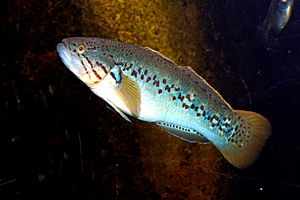Mogurnda adspersa facts for kids
Quick facts for kids Mogurnda adspersa |
|
|---|---|
 |
|
| Scientific classification | |
| Synonyms | |
|
The southern purple-spotted gudgeon (also known as Mogurnda adspersa) is a special type of fish. It lives only in southeastern Australia. This fish is usually brown with colorful spots on its sides. For a while, people thought this fish had disappeared forever. But in 2002, a few were found again! Now, the Australian government is working hard to help more of these fish survive.
Contents
What Does It Look Like?
The southern purple-spotted gudgeon has a clever way of blending in. It is dark brown on its back, which helps it hide from things looking down from above. Its sides and belly are lighter, like light brown or cream. This helps it hide from things looking up from below. This special coloring is called countershading.
This fish has three red stripes on each cheek. It also has cool spots of red, purple, black, and white along its body. These spots become even brighter and easier to see when the fish is ready to lay eggs. Most of these gudgeons are about 8 cm (3 inches) long. However, some can grow a bit bigger, up to 14 cm (5.5 inches).
Where Does It Live?
The southern purple-spotted gudgeon is found only in southeastern Australia. It especially likes the Murray-Darling basin and rivers near the coast, north of the Clarence River.
This fish usually lives near the bottom of calm rivers or creeks. It likes to swim among underwater plants, tree branches, and rocks. These places give it good spots to hide and find food.
What Does It Eat?
The southern purple-spotted gudgeon enjoys a varied diet. It eats small fish and plants. It also likes other small creatures. These include tiny shrimp, worms, tadpoles, insect larvae, and small crustaceans.
Life Cycle and Reproduction
The breeding season for these gudgeons usually happens from November to March. During this time, the female fish lays many batches of eggs. She can lay anywhere from 30 to 1,300 eggs at a time!
The female lays her eggs on objects or plants that are underwater. After the eggs are laid, the male fish takes over. He guards the eggs carefully and uses his fins to fan them. This helps keep the eggs clean and healthy. The young fish hatch from the eggs after about 3 to 9 days.
Helping the Southern Purple-Spotted Gudgeon
In the 1980s, the number of southern purple-spotted gudgeons dropped very quickly. This happened because new fish that ate them were introduced. There was also less food, and water levels changed, which made it hard for them to breed. People thought the fish had disappeared completely.
But in 2002, a small group of these fish was found again in the Murray–Darling basin! To help them, the New South Wales Department of Primary Industries started a special program. They are raising these fish in captivity. The goal is to release these fish into the wild. This will help the wild fish populations grow stronger and recover.
The southern purple-spotted gudgeon is now considered a threatened fish in Victoria. It is endangered in New South Wales. In South Australia, it is even more at risk, being critically endangered.

